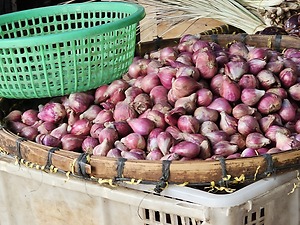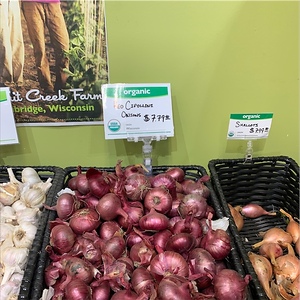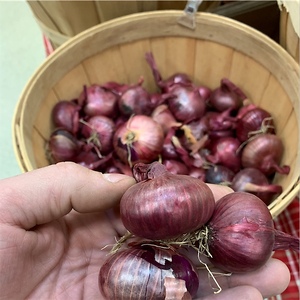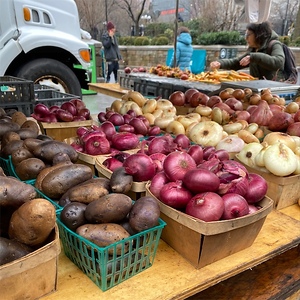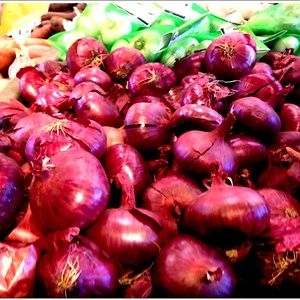


Red Cipollini Onions
Estimated Inventory, 10 lbs : 0
Description/Taste
Red Cipollini onions are small in size, averaging 3-8 centimeters in diameter, and have petite, saucer-shaped bulbs that are round and slightly flattened in shape. The bulb is covered in a thin, ruby-copper, papery parchment skin that adheres tightly to the flesh. Underneath the skin, the purple-red, almost translucent flesh is firm, juicy, and has many layers of white rings. In their raw state, Red Cipollini onions have a mild aroma, are crisp, and are semi-sweet with a pungent flavor, but once cooked, they sweeten and soften into a tender, almost melting, texture.
Seasons/Availability
Red Cipollini onions are available year-round, with a peak season in the fall.
Current Facts
Red Cipollini onions, botanically classified as Allium cepa, are an Italian heirloom variety that is a member of the Amaryllidaceae family. Also known as Borettane or Cipolline onions, the name Cipollini also translates from Italian to mean "little onion," and is valued by chefs and home cooks for its tender texture, small size, and caramelized, sweet flavor when cooked.
Nutritional Value
Red Cipollini onions contain potassium, vitamin B6, fiber, manganese, and vitamin C.
Applications
Red Cipollini onions are best suited for both raw and cooked applications such as roasting, baking, sautéing, and pickling. When used fresh, the petite onions can be quickly blanched in boiling water and then placed in an ice bath to help loosen the thin, papery skin for easier removal. The high sugar content of the Red Cipollini onion also allows for flavorful caramelization and is used whole in stews, roasts, or casseroles. The onion can be chopped and mixed into cabbage salads, mushroom tarts, pasta, potato salads, skewered on kabobs, or pickled and served as a condiment with charcuterie and aged meats. The onion can also be served as a side dish with fried gnocchi and salami or in a sweet and sour sauce. Red Cipollini onions pair well with eggs, poultry, ham, seafood, balsamic vinegar, mushrooms, chives, green onions, fennel, herbs such as parsley, thyme, and rosemary, tomatoes, carrots, cabbage, pistachios, ricotta cheese, parmesan cheese, potatoes, olives, and red wine. The bulbs will keep up to two months when stored in a cool and dry place.
Ethnic/Cultural Info
Red Cipollini onions originated in the Reggio Emilia province of Italy, which is an area also known for "Prosciutto of Parma” ham and “Parmigiano Reggiano.” The small bulbs are traditionally braised in a sweet and sour tomato sauce, consisting of tomatoes, salt, pepper, vinegar, and olive oil. Cipollini onions were once considered a poor man’s food in ancient Rome around 1500 BCE, but today the onions have grown in popularity and are commonly served at high ends restaurants and are sold at gourmet shops.
Geography/History
Red Cipollini onions are native to Boretto, Italy and were cultivated in the 1400s. Originally grown for domestic distribution, the Cipollini onion became widespread as the bulbs traveled across Europe and subsequently to America with Italian immigrants. Today Red Cipollini onions are now grown around the world in Mediterranean climates and can be found at farmers markets and specialty grocers in North America, Europe, Asia, and Australia.
Recipe Ideas
Recipes that include Red Cipollini Onions. One



